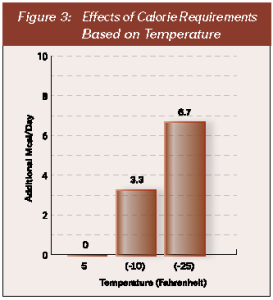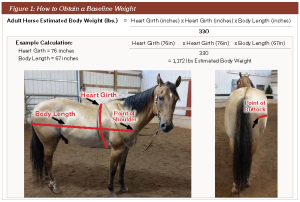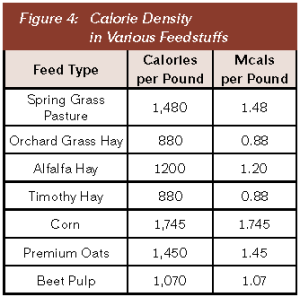Cold Weather Care For Horses
Click here to view as a pdf: Cold Weather Care For Horses
By Kaylee Viney, Livestock Specialist
When cold weather strikes what will your horse be telling you? Cold weather can be hard on horses and it is important that they are ready for the rigors of winter. Proper body condition and weight are crucial going into the cold weather season. The following article will provide cold weather feeding tips to maintaining your horse’s weight and overall health. Implementing these tips will allow more enjoyment for you and your horse during the snow covered season.
Establishing a Baseline Body Weight:
Establishing a baseline body weight is important in tracking health changes and adjusting your horse’s feeding program. The best way to determine your horse’s current weight is by using a body weight tape. A body weight tape is a flexible fabric strip, resembling a tape measure, that is calibrated to estimate a horse’s weight. To use a weight tape you start by taking measurements 1) around the girth behind the withers and 2) from the point of shoulder to point of buttock. Insert these measurements into the formula given with the weight tape, which is specifically calibrated for horses, to accurately estimate body weight. (See Figure 1.) Weight tapes can be found for many species of livestock, so make sure to have a weight tape labeled for equine use. Weight tapes can be purchased at most farm supply stores or vet clinics.
The establishment of a baseline weight is helpful in monitoring body condition from season to season and year to year. It also provides guidance for nutritional changes to be made during times of heavy work. It is best to measure at a time of year when the horse has minimal changes to their diet, work load and other stressors. Fall is an ideal time to establish a baseline weight because most horses will be done with field work or their high stress show season. It is important to measure your horse before winter weather sets in.
 Caloric Intake Requirements:
Caloric Intake Requirements:
Every animal species has a caloric intake requirement for maintenance of health. The caloric requirement in horses is measured in megacalories (Mcals). 1Mcal = 1000 calories. As shown in Figure 2, the caloric requirements necessary to maintain body weight are based on baseline weight and exercise level. However, when the temperature drops below the lower critical temperature of 5°F (-15°C), the caloric requirements increase 20% for every 14°F drop in temperature.
Figure 3 shows the additional Mcals needed per day based on an 1,100 pound horse with a moderate activity level. For example: in order to maintain condition on an 1,100 pound horse with moderate activity in temperatures of -10°F or lower, you must add the calories pictured in Figure 3 (+3.3 Mcals) to the horse’s megacalorie requirements pictured in Figure 2 (16.4Mcals) = 19.7Mcals total. 
See Figure 4 to compare how different feed ingredients vary in their calorie density. This chart can be used to estimate how many calories your horse is receiving each day and gives you an idea on how to increase the calories fed during cold weather. Horses need these additional calories to maintain body function and stay warm. Just like humans, horses in colder temperatures begin to shiver, which is a reflexive response to help maintain their core body temperature. By using the vast majority of their dietary energy to maintain their body heat, it is more difficult for horses to support proper health during cold weather. If the horse’s daily caloric intake is not increased during cold weather, a significant amount of body weight can be lost in a short amount of time; leading to potential health problems.
Don’t Forget the Forage and Minerals:
Along with balancing the dietary energy (Mcals) it is important to ensure the proper amount of quality forage in the ration. For example, an 1,100 pound horse has a forage requirement of 2% of its body weight per day (22 pounds). As the winter months continue, energy demands increase. Over mature hays will not supply sufficient energy and are high in undigestible fiber. It is therefore important to use sufficient quantities of highly digestible hay. Forage digestion helps horses regulate their body temperature and stay warm. The breakdown of fiber in the horse’s digestive tract, through the fermentation process, results in heat generation. The more efficient the fiber digestion, the more heat production there is which aids in maintaining core body temperature. Efficient digestion is key in allowing horses to absorb essential nutrients necessary in maintaining proper health and body condition. Make sure you carefully weigh your forage and grain mix by using a scale. Grains and forages should be measured in pounds, not “flakes” or “scoops” which are inconsistent measurements for caloric requirements. Weighing in pounds will determine the actual amount of calories being fed.
To give your horse a strong nutritional foundation feed Crystal Advantage® equine minerals. Crystal Advantage® equine minerals are formulated with highly bioavailable polysaccharide chelated trace minerals and are available in granular or pelleted form. When using Crystal Advantage® equine minerals along with basic grains such as corn and/or oats, there is no need to supplement with other additives. If you are looking for a strategic equine nutrition supplement to support your horse during stressful times (heat, cold, travel or exercise) Crystal Advantage® Digestive Support is the product to use. The naturally derived ingredients in Crystal Advantage® Digestive Support have been scientifically proven to stimulate the immune system along the gastrointestinal tract, decrease inflammation, promote nutrient absorption in the lower gastrointestinal tract and stop/reverse gastric ulcer formation in laboratory models.
Water Intake Supports Feed Intake:
In all species of livestock, abundant access to clean fresh water is necessary to support feed intake. During winter months, waterers can become frozen; reducing access to water. Not having a proper water supply increases the incidence of colic due to dehydration and inconsistent feed intake. If your animals are dehydrated, make sure to bring them into a shelter and provide a bucket of warm water with electrolytes. If they don’t drink and you see signs of colic (such as minimal feces, kicking at their side, or wanting to lie down and not get up) contact your veterinarian. Dehydration can be avoided by regularly de-icing all water tanks or investing in heated water buckets or automatic waterers.
Over Blanketing:
Over blanketing horses is another common cause of dehydration. If your horse is body clipped, or sensitive to colder weather, you can invest in a winter blanket to protect them from the cold. Never over-lap or pile multiple blankets on horses. Winter blankets are nice to have on hand if necessary but horses are bred with coats that are able to withstand freezing temperatures. Too many blankets can cause horses to overheat and become dehydrated. When purchasing a winter blanket for your horse, make sure it is waterproof to ensure moisture does not get trapped between the coat of the animal and the blanket; causing your horse to get chilled. 
With cold weather coming soon make sure you have used a weight tape to measure your horse’s baseline weight. As the days shorten and temperature drops, be prepared to adjust your horse’s feeding program to maintain their body condition and overall health. For additional information on equine nutrition visit our website www.crystalcreeknatural.com and click on the “Articles” tab or contact one of the helpful Crystal Creek® Nutritionists or Livestock Specialists by calling 1-888-376-6777.
Source:
Figure 2. Nutrient Requirements of Horses: Sixth Revised Edition (2007)
Figure 4: Nutrient Requirements of Beef Cattle (2000)
Advances in Equine Nutrition IV


